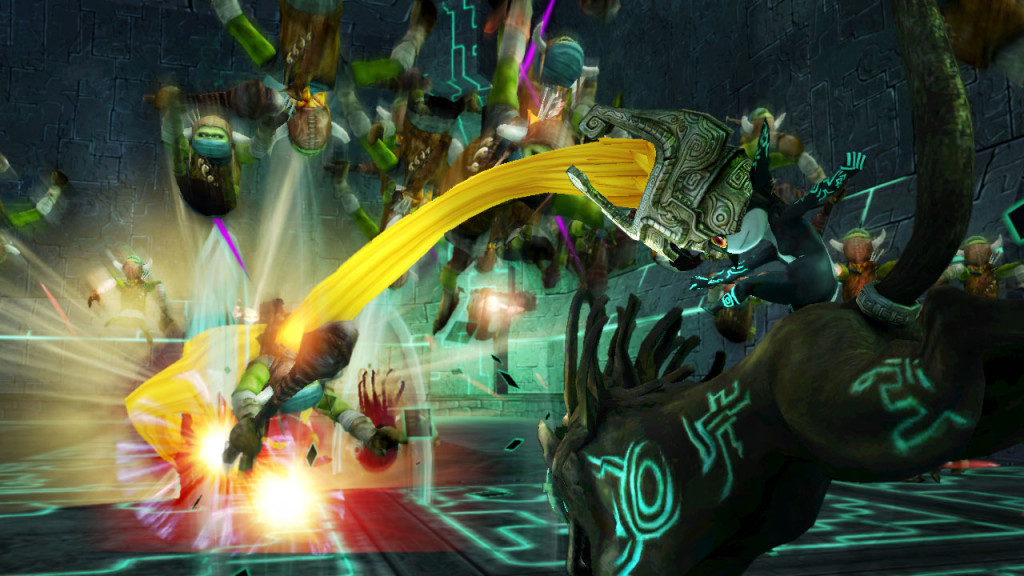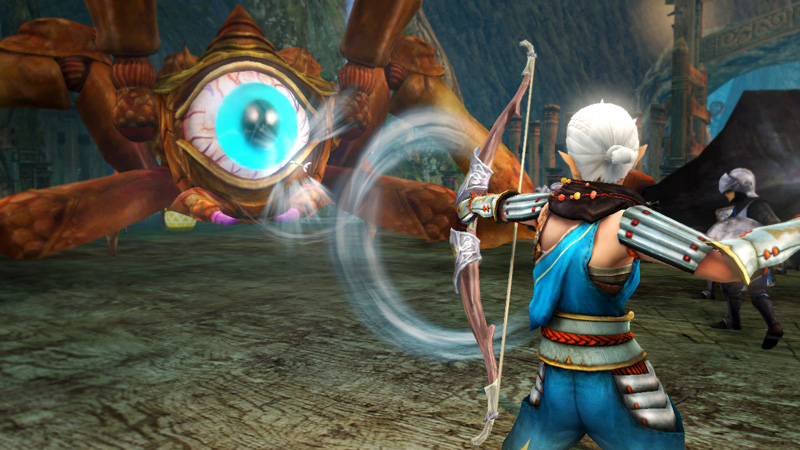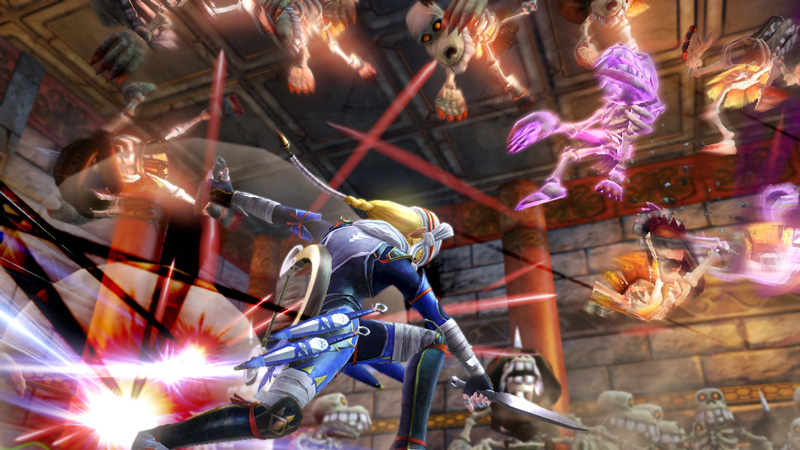Last updated on January 16, 2015
-
Introduction (January 13th)
-
Combat (January 14th)
-
Structure (January 15th)
-
Polish and Conclusions (January 16th)
Combat
I’m not sure why every Warriors game gets called “repetitive”, as if people just refuse to admit there’s any depth, but they’re wrong – that’s especially true of Hyrule Warriors. Hyrule Warriors vastly improves upon the combat of both Zelda games and Dynasty Warriors by liberally stealing elements from both series. On the one hand, you’ll fight thousands of enemies and generals in various locations as you’d expect. Regular Attacks move into Combo attacks, and you know the rest. Special Attacks work just like Musou Attacks (although you can obtain up to three Special Attack meters), and Focus Spirit works similarly to Rage Mode (although you can lengthen its duration by killing more enemies, thereby earning rewards and bonuses). Nothing seems too out of the ordinary so far if you ever played a Dynasty Warriors game except for the 30 FPS framerate. It can chug, but the draw distance remains surprisingly high with few pop-ins even with hundreds of enemies onscreen, which can’t be said for most mainline entries in the series.
On the other hand, fighting tougher enemies requires the good old Z-targeting (now L-targeting, for you younger folks) system augmented with Skyward Sword’s Weak Points system. Every named enemy requires you to lock onto them, analyze their attack patterns, and retaliate when the Weak Point marker appears above their head. Drain the Weak Point Market to do a Weak Point Smash, a powerful attack that also acts as a screen clearing agent and does a ton of damage to the officer in question. I gotta say, I expected this system to present the same problem it always does in 3D Zelda combat: lots and lots of waiting. Thankfully, Hyrule Warriors will throw multiple enemies like this on the battlefield in groups, really placing you on your toes. Just attacking them will not do the job; you need to spend as little time as possible on them, and this waiting game creates a palpable sense of tension when the rest of your fighting force is struggling to survive. Officer combat, in that sense, becomes a heck of a lot more interesting by default!
Attack strings prove to have incredible variation and use even within single weapon combat (no dual weapon switching here!), as a lot of weapons hold lots of secret nuances. Each character actually feels useful for different purposes; Link does your all-purpose combat (assuming you select sword), but a character like Midna can crowd-control like nobody else. Ruto, weirdly enough, uses a special meter for ranged combat, while an unorthodox character like Agitha or Zant take some practice to unleash their potential. The wide variation of characters. expertly chosen for character variety and not merely fanservice, shows they cared a lot about the actual game underneath.
Let me explain a little bit. Zant has the Twilight Meter, which he needs to charge via certain combos with repeated button presses. Press the button too many times at the end, overfilling the meter, and he’ll be stunned – that kind of thing will kill you. However, if you can consistently pull it off, he gains enhanced attack speed and an unbelievably whirlwing crowd-clearing attack along with other combo enhancements. Ghirahim can lock onto any Z-Target enemy for 8 seconds or so, enhancing his combo strings with new attacks and variations. Link’s Master Sword (unsurprisingly) shoots beams of light if you’re at full health, making it the best weapon in the game by a mile. There are a ton of nuances like this to every character, some more subtle than others, but I’ve found individual nuances for just about every combo string with every character. It’s literally amazing how much detail they put into something like this, and they don’t sacrifice the game at the altar of fanservice for it!
Additionally, Warriors in Hyrule give a much better gamefeel than their Dynasty counterparts, mostly due to Team Ninja’s involvement in the game. As such, there’s now a dodge button with invincibility frames, allowing you to cancel out of attacks with long recovery animations. If four Poes throw projectiles at you at the same time, you will literally be in love with the dodge button! Holding down said dodge button while holding forward will immediately make you run, eliminating the guesswork of fast movement around the map (you lose horses, but I honestly could care less in a fantasy world like this). Combat feels incredible fast and fluid, and your movement options mean you can take care of any threat if you’re paying attention.
And there are threats, I assure you. Enemy officers will require your attention, as always, but multiple officers with different attacks and totally different movesets? Fighting a Shield Moblin, a Lizalfos, and a Giant Icy Poe at the same time proves to be quite a handful! The Giant Bosses, such as Dodongos and Gohmas, remain an excellent addition, echoing Zelda’s pattern-based “find the weakness” style in the middle of battle. Yes, there’s only a few of them, but just wait until they throw multiple bosses at you! Fighting them always requires your attention.
Knowing this as a Dynasty Warriors game, though, you will absolutely need to multitask on nearly every battlefield, making each minor skirmish a trade-off of time versus objectives. Unlike its main series counterparts, Hyrule Warriors focuses the heat of battle on “Keeps”. You can think of Keeps as enemy bases; you need to kill a certain number of enemies in the base to make the Keep Boss appear, and killing him claims the Keep for your side. Outposts work generally the same, although they generate far less troops – they will just annoy you on the way to your next objective.
To keep the battlefield active, each side will send Raid Captains to the nearest enemy base to try to claim it. As usual in these games, you usually decide every conflict, but you can’t deal with multiple bases a time. Which ones do you need to keep? Which capture will lower your troops’ morale, thus making it harder to win? Which one is the enemy sending a siege weapon to take? Add the tides of war, which can turn just via new Objectives and threats popping onto the scene, and you’ve got yourself a stressful good old time.
I think that’s my favorite part of Hyrule Warriors. Unlike other Dynasty Warriors games, I really felt the heat with all manner of events happening at any one time. The default difficulty presents quite a stiff challenge if you aren’t ready for it, as you need to adjust at a moment’s notice to a new threat. Killing enemy captains can take time, and it might not be time you have, but they can easily snatch an important choke point while you deal with other stuff. Running around the battlefield just happens by necessity now, and the tension is palpable.
Trust me, I think I’m pretty good at video games (and, let’s say, Warriors games), and I find myself staring at a You Lost screen much more than I thought I would upon embarking upon this Hyrule excursion. If you come in with a plan and a strategy, any battle will tip in your favor, but just leveling yourself up will not do. I mention this due to the common complaints against the series demanding grinding, and I assure you this one won’t let you (unless you’ve got tons of free time and hate challenges, I guess). The combat and design, in a word, strike me as marvelous, and a wonderful surprise!



